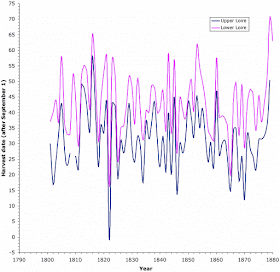Phenological patterns are often highly correlated with temperatures. As noted by Chuine et al. (2004):
Biological and documentary proxy records have been widely used to reconstruct temperature variations to assess the exceptional character of recent climate fluctuations. Grape-harvest dates, which are tightly related to temperature, have been recorded locally for centuries in many European countries. These dates may therefore provide one of the longest uninterrupted series of regional temperature anomalies (highs and lows).Harvest dates of grapes in western Europe (used for wine-making) are of especial interest because they constitute long phenological records, as a result of the fact that the harvest dates are usually officially decreed, based on the ripeness of the grapes. In other words, we have historical records for many locations over many years.
Daux et al. (2012) have compiled many of these records into a publicly accessible database archived at the World Data Center for Paleoclimatology.
This database comprises time series for 380 locations, mainly from France (93% of the data) as well as from Germany, Switzerland, Italy, Spain and Luxembourg. The series have variable lengths up to 479 years, with the oldest harvest date being for 1354 CE in Burgundy. The series are grouped into 27 regions "according to their location, to geomorphological and geological criteria, and to past and present grape varieties." These regions are shown in the map.
Normally, such data would simply be graphed as a time series for each region. However, as usual in this blog, we can examine these data using a phylogenetic network, to perform an exploratory data analysis. However, most of the data are actually "missing", because most of the time series have time gaps or cover only short periods. So, to create a more complete dataset I have extracted the data for the years 1800-1880, inclusive, because for this period 17 of the regions have mostly a complete series.
Two of the time series are shown in the first graph. This shows that the two time series are highly correlated, as are most of them. In this case, the correlation coefficient is 0.87.
I then used the gower distance to calculate the similarity of the different years and regions, based on the harvest dates (the gower measure is needed in order to deal with the fact that some of the data are still missing). This was followed by a neighbor-net analysis to display the between-region and the between-year similarities as two phylogenetic networks.
Only the first network is shown here. Regions that are closely connected in the network are similar to each other based on the variation in their harvest dates through time, and those that are further apart are progressively more different from each other.
Many of the patterns here are to be expected, based on the geographical proximities of the regions, but some are not. For example, Ile de France, Champagne and Vendée - Poitou Charente are all in northern France (see the map) while Bordeaux is in the south-west, and the Rhone Valley regions are in the south-east. As Le Roy Ladurie & Baulant (1980) have noted, the vineyards of northern and central France are in a different climatic zone from the wine regions of southern France (to the south of the Geneva parallel) and those of western France (west of the Chateau-du-Loire meridian).
Similarly, at the other end of the network, the Lower Loire region is not geographically located near any of the associated regions in the network. Possibly the most unexpected pattern, then, is the network separation of the Upper and Lower regions of the Loire Valley, which are the two regions whose time series are graphed above.
Clearly, the network is displaying only quite small differences between the time series. That is, the time patterns are very consistent across the regions, which does indeed make them useful for studying past temperature patterns.
References
Isabel Chuine, Pascal Yiou, Nicolas Viovy, Bernard Seguin, Valérie Daux, Emmanuel Le Roy Ladurie (2004) Grape ripening as a past climate indicator. Nature 432: 289-290.
V. Daux, I. Garcia de Cortazar-Atauri, P. Yiou, I. Chuine, E. Garnier, E. Le Roy Ladurie, O. Mestre, J. Tardaguila (2012) An open-database of grape harvest dates for climate research: data description and quality assessment. Climate of the Past 8: 1403-1418.
Emmanuel Le Roy Ladurie and Micheline Baulant (1980) Grape harvests from the fifteenth through the nineteenth centuries. Journal of Interdisciplinary History 10: 839-849.




No comments:
Post a Comment